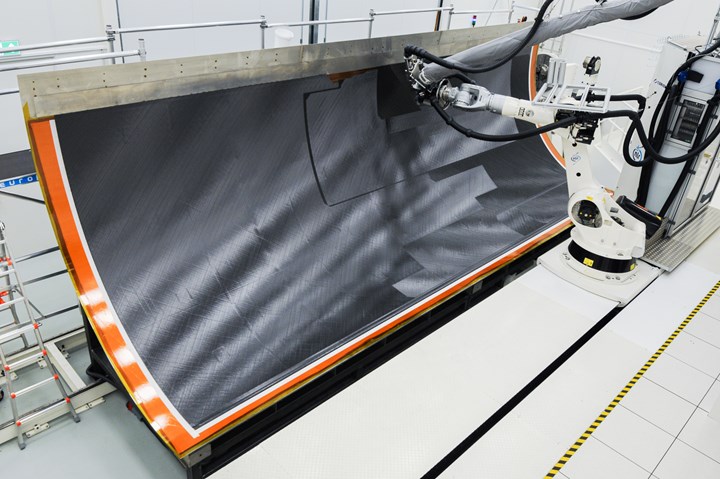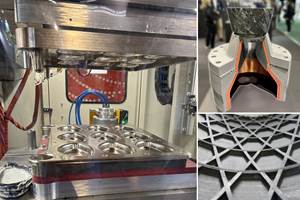STUNNING project successfully develops 8.5-meter thermoplastic fuselage skin
Clean Sky 2 project under the MFFD program produces two segments of an 8.5-meter-long, 4-meter-diameter thermoplastic fuselage skin via NLR’s in-house AFP machine, with consolidation plans this summer.

Photo Credit: The NLR
As part of the EU’s Clean Sky 2 initiative, the aerospace industry is looking for flight path to sustainability, particularly through the transition from aluminum to carbon fiber-reinforced composites to improve aircraft structures and greatly reduce emissions. The Clean Sky 2 Multifunctional Fuselage Demonstrator (MFFD), is one such program that began back in 2017, composed of dozens of individual projects and work packages (for more on these, see “Proving out LM PAEK welding for Multifunctional Fuselage Demonstrator”). In particular, the STUNNING (SmarT mUlti-fuNctionNal and INtegrated thermoplastic fuselaGe) project, which is set to develop the lower fuselage section of the MFFD, has recently produced an 8.5-meter-long fuselage skin made of thermoplastics via automated fiber placement (AFP) (see video below).
STUNNING is led by GKN Fokker (Papendrecht, Netherlands) with key partners Diehl Aviation (Laupheim, Germany), Netherlands Aerospace Centre (NLR, Amsterdam, Netherlands) and Delft University of Technology (TU Delft, Delft, Netherlands). The project aims to further mature automated assembly processes, thermoplastic manufacturing and welding technologies, integrated design and manufacturing development and advanced electrical systems architectures.
“Probably half of the aerospace industry in Europe is involved in the MFFD project, as we really dig into researching various manufacturing techniques all with sustainability in mind,” describes Joachim de Kruijk, senior R&D composites engineer at NLR. “In researching the various manufacturing options and materials, we believe the best way to achieve this goal of a more sustainable fuselage structure is to utilize the new generation of thermoplastic materials. We see that such a material can enable a change in manufacturing approach and design techniques that can result in much lighter aircraft, which means less fuel burn and lower emissions of CO2 and NOx, all while maintaining the strength and safety we expect from traditional aluminum aircraft.”
A number of modern aircraft, such as the Airbus A350 XWB and the Boeing 787 Dreamliner already use thermoset composite materials in the construction of parts and brackets and even the skin of the fuselage, Clean Sky notes. In the STUNNING project, however, experts at GKN Fokker and NLR were tasked with the design for manufacturing enabling high production rates of large, structural parts for aircraft.
“One of the real improvements offered by the use of thermoplastics is that during the manufacturing and assembly process, unlike thermosets, this material can be heated and reheated multiple times to ensure uniformity and bonding,” explains De Kruijk. “In STUNNING, one of our objectives was to show how the different processes could be combined to build both structural and non-structural components for complete integration. To do this, we set out to build the entire bottom half of a fuselage to gain insights not only in manufacturability of the skin of the aircraft, but also the sub structures like the stiffeners for under the skin, and other structural pieces like floor beams, as well as parts of the cabin, the systems and even cargo doors.”
With these lofty goals in mind, collaborators set out to test their various manufacturing techniques to build the numerous parts and structures to be integrated into a fuselage. For NLR, this meant testing its knowledge and production abilities with the biggest part of them all, the underbelly of the fuselage structure. With the help of its in-house, state-of-the-art AFP machine, NLR reportedly hit its target, building the bottom half of fuselage skin — a single piece, measuring in at 8.5 meters long by 4 meters in diameter — said to be the largest known single thermoplastic piece ever made.
This was no small feat, Clean Sky says. While composite materials like thermosets have been increasingly used in airplane construction, large thermoplastic parts are relatively new to the field, which also means it can be a little more costly, in comparison. But according to De Kruijk, that’s just at face value, as the benefits greatly outweigh the price.
“Because it’s newer and due to its properties, thermoplastics are a little more expensive than thermosets. But there are a number of differentiating factors that make the use of the new material worth it. For instance, thermoplastics are a little lighter than thermosets because it’s a tougher matrix material and has a better resistance to impact damage, which is important,” explains De Kruijk. “Beyond that, however, is the means by which the material can be used in manufacturing. To connect various parts or pieces of thermoplastics, you simply need to heat the material to weld it together. That means we’re getting rid of the hundreds of thousands of the fasteners holding conventional planes together, which will undoubtedly lead to more dramatic savings in weight.”
Another topic that NLR has been tasked with researching is how to inspect, maintain and repair aircraft constructed from thermoplastics. As of now, the use of large composite parts in planes is somewhat limited, which means there’s much less data and practice in inspection, maintenance and repairability.
“Currently, we’re working on developing technology for a number of non-destructive inspection [NDI] techniques to use to inspect planes, such as thermography and shearography, but that technology is still maturing. Currently, we employ ultrasonic inspection to check for defects and issues, but that can be a time-consuming process,” suggests De Kruijk. “However, current inspection and maintenance of conventional aircraft is also slow. Because of the nature of thermoplastics, with the ability to be reheated and welded together, we see that maintenance can be done much faster than on traditional aircraft. Just imagine how much time can be saved by not having to hand check every single rivet across the entire structure, individually.”
Due to the size of the final skin, two segments were produced. With the completion of the lay-up of the second 90-degree segment of the lower fuselage skin, the next step is to consolidate and to join the two 90-degree segments of the lower fuselage skin to an 180-degree fuselage skin segment. To do this, however, reportedly requires a very large autoclave that is capable of both fitting and heating the over-sized pieces to join them together. Because there is no such autoclave in the Netherlands, the two halves are headed to Germany for integration. The process was slated to take place at the end of June.
“Assuming we can push forward with connecting these two pieces of the fuselage in June, we expect that we can have the consolidated skin back at NLR by summer to start the detailed NDI process to test and see verify its success and thoroughly establish the quality of the complete lower fuselage skin,” illustrates De Kruijk. “After that, we will ship it to our partners at GKN Fokker, where the various parts that were developed in the STUNNING project can be fully assembled and integrated.”
For a complete summary on the MFFD project, see “Moving forward on the Multifunctional Fuselage Demonstrator (MFFD).” For more on induction welding, view this webinar presented by GKN Fokker.
This project has received funding from the Clean Sky 2 Joint Undertaking (JU) under grant agreement No 945583. The JU receives support from the European Union’s Horizon 2020 research and innovation program and the Clean Sky 2 JU members other than the Union.
Related Content
JEC World 2024 highlights: Thermoplastic composites, CMC and novel processes
CW senior technical editor Ginger Gardiner discusses some of the developments and demonstrators shown at the industry’s largest composites exhibition and conference.
Read MorePlant tour: Joby Aviation, Marina, Calif., U.S.
As the advanced air mobility market begins to take shape, market leader Joby Aviation works to industrialize composites manufacturing for its first-generation, composites-intensive, all-electric air taxi.
Read MoreThermoplastic composites: Cracking the horizontal body panel nut
Versatile sandwich panel technology solves decades-long exterior automotive challenge.
Read MoreThe potential for thermoplastic composite nacelles
Collins Aerospace draws on global team, decades of experience to demonstrate large, curved AFP and welded structures for the next generation of aircraft.
Read MoreRead Next
Developing bonded composite repair for ships, offshore units
Bureau Veritas and industry partners issue guidelines and pave the way for certification via StrengthBond Offshore project.
Read MoreVIDEO: High-volume processing for fiberglass components
Cannon Ergos, a company specializing in high-ton presses and equipment for composites fabrication and plastics processing, displayed automotive and industrial components at CAMX 2024.
Read MoreAll-recycled, needle-punched nonwoven CFRP slashes carbon footprint of Formula 2 seat
Dallara and Tenowo collaborate to produce a race-ready Formula 2 seat using recycled carbon fiber, reducing CO2 emissions by 97.5% compared to virgin materials.
Read More















.jpg;maxWidth=300;quality=90)










